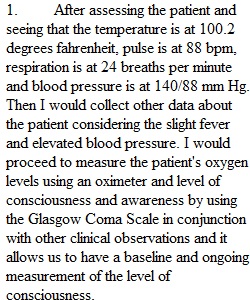


Q For this assignment, you will complete Critical Thinking Activities based on your Chapter 12 readings in Foundations and Adult Health Nursing. Please review the Critical Thinking prompts below providing a response for each that is at least 150 words in length. Your responses should be well-written, in your own words, and submitted via an upload below using a Word or Google document. If you have questions about formatting or how to cite your sources, please review the IOT Writing Guide and APA Download IOT Writing Guide and APAguidelines. If you have any questions, please reach out to your instructor! ________________________________________ Week 3: Critical Thinking Activities 1. A patient is assigned to you with a diagnosis of flank pain; you obtain vital signs and determine that they have changed from those of the previous shift, which were: T 100.1° F, P 80, R 18, and B/P 122/70 mm Hg. You obtain vital signs of T 100.2° F, P 88, R 24, and B/P 140/88 mm Hg. What other data should be collected? 2. The nurse is caring for a patient who has been in the hospital for pneumonia and has had an increase in blood pressure during the night. What parameters are essential in monitoring and reporting blood pressure and other vital signs? Rubric W3: Critical Thinking Lab W3: Critical Thinking Lab Criteria Ratings Pts This criterion is linked to a Learning OutcomeCritical Thinking Prompts The student will be awarded a maximum of 10 points per answer. Points will be deducted if necessary; please see instructor feedback. 20 pts Total Points: 20 PreviousNext
View Related Questions